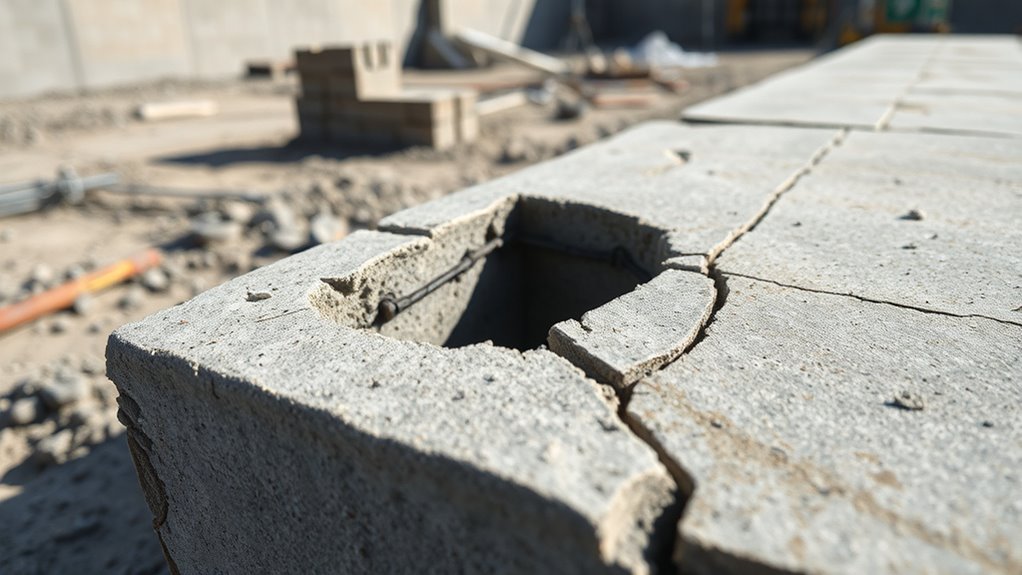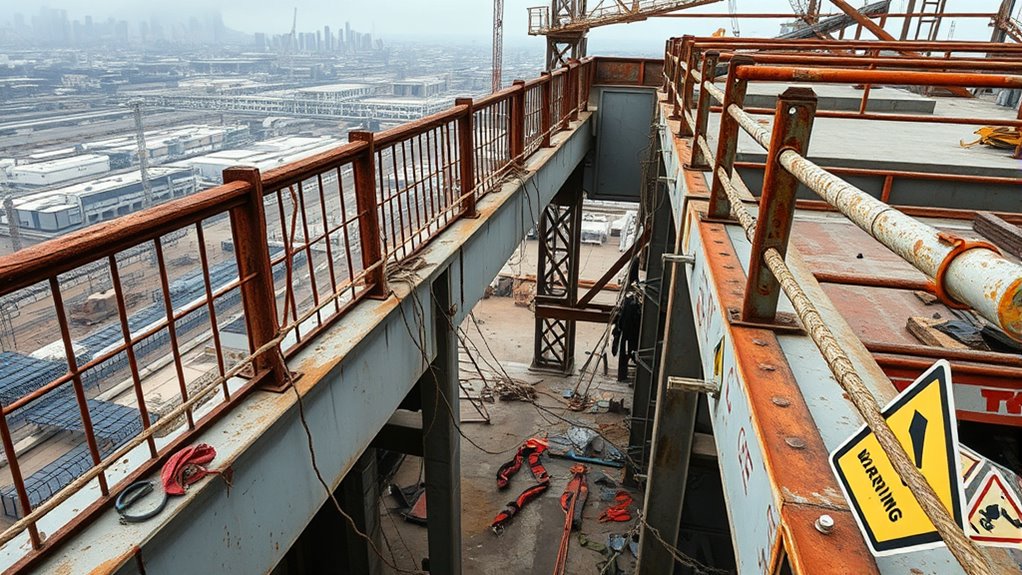When hiring a contractor for vanishing edge pools, watch out for red flags like lack of specialized experience, missing permits, and poor quality materials. Be cautious if they don’t show a solid portfolio or are vague about costs and timelines. Safety lapses and negative reviews about past work can also indicate trouble ahead. Recognizing these warning signs from the start can help prevent costly mistakes—if you continue, you’ll discover how to spot even more warning signs.
Key Takeaways
- Lack of specialized vanishing edge experience and proven project portfolio.
- Absence of proper permits, licensing, or certification verification.
- Use of low-quality materials and inadequate site assessment.
- No detailed project plans, structural analysis, or clear timelines.
- Poor safety protocols, outdated equipment, or negative references on craftsmanship.
Lack of Specialized Vanishing Edge Experience

If a contractor lacks specialized vanishing edge experience, it can lead to serious issues with your project. Vanishing edges require precise craftsmanship and an understanding of specific techniques to ensure a seamless look and structural integrity. Without this expertise, you risk uneven surfaces, water drainage problems, or even structural failure. A contractor unfamiliar with vanishing edge details might cut corners, use improper materials, or misjudge the installation process. Proper material selection is essential for a durable and visually appealing vanishing edge, and lacking this knowledge can compromise the entire project. This can result in costly repairs or replacements down the line. You need someone who has completed multiple vanishing edge projects successfully, understands the unique challenges, and can deliver a flawless finish. Don’t settle for a general contractor; verify they have the specialized experience necessary for this intricate work.
Absence of Proper Permitting and Certifications

If a contractor can’t provide permit documentation or certification credentials, it’s a major red flag. You should verify their licensing status to confirm they’re authorized to work legally in your area. Skipping these steps can lead to costly delays and potential legal issues down the line. Additionally, ensuring the contractor has proper training and credentials helps safeguard your project’s safety and compliance.
Missing Permit Documentation
Have you checked whether your contractor has all the necessary permits and certifications? Missing permit documentation is a clear red flag. Without proper permits, your project may face delays, fines, or even legal issues. It also suggests the contractor might cut corners or isn’t experienced enough to handle the job correctly. To avoid problems, ensure you verify:
- That permits align with local building codes
- If permits are issued before work begins
- That permits cover all aspects of the project
- Whether the contractor can provide copies upon request
- Confirming that permits are obtained from official authorities helps ensure legitimacy and compliance.
Failing to secure proper documentation indicates a lack of professionalism and raises doubts about the quality and legality of the work. Always double-check permits before starting to protect your investment.
Lack of Certification Credentials
Are you confident your contractor holds all the necessary certifications and permits? If not, that’s a red flag. Proper certifications ensure the contractor has the training and expertise to do quality work safely and legally. Without these credentials, you risk subpar installation, safety hazards, and potential legal issues. Always ask for proof of certifications, such as industry-specific licenses or manufacturer-trained credentials. Verify their validity with the issuing agencies. A contractor lacking legitimate certifications might cut corners or use inferior materials, jeopardizing your vanishing edge’s integrity. Don’t accept vague assurances; demand concrete proof. Working with certified professionals not only safeguards your investment but also ensures the project meets required standards and regulations. Additionally, proper licensing and permits are essential for legal compliance and can help resolve disputes if they arise. If your contractor can’t provide proper certifications, it’s best to reconsider before proceeding.
Unverified Licensing Status
An unverified licensing status should raise immediate concerns because it indicates your contractor may not have the legal authority to perform the work. Without proper licensing, you risk subpar quality, legal issues, and potential project delays. To evaluate a contractor’s licensing, consider these points:
- Verify their license with local licensing boards to confirm current status.
- Ensure the license covers the specific work you need, like vanishing edges.
- Check for any complaints or disciplinary actions against the licensee.
- Request proof of licensing before signing any agreement.
- Confirm that their licensing is valid and up-to-date, as expired licenses can lead to complications.
Use of Low-Quality or Inappropriate Materials

How can you identify a contractor who cuts corners? One key sign is their use of low-quality or inappropriate materials. If they suggest cheaper alternatives that aren’t suitable for a vanishing edge pool, that’s a red flag. These materials might look fine initially but can cause long-term damage, leaks, or structural issues. For example, using subpar waterproofing or inferior tiles can lead to costly repairs later. A reputable contractor recommends durable, suitable materials that meet industry standards. They won’t cut corners just to save money. Always ask for detailed material specifications and verify their quality. If a contractor resists providing this information or pushes cheaper options, consider that a warning sign. Cutting corners with materials compromises safety, longevity, and your investment. Additionally, proper material selection is crucial for ensuring the pool’s waterproofing quality and overall durability over time.
Inadequate Site Assessment and Planning

If a contractor skips a thorough site evaluation, they risk overlooking potential hazards or unique conditions that could impact the project. Without detailed plans, the work may lack direction, leading to costly mistakes or delays. Insufficient structural analysis can compromise safety and durability, revealing a lack of proper planning before breaking ground. Additionally, neglecting to utilize effective site assessment tools can hinder accurate project estimation and risk management.
Poor Site Evaluation
Poor site evaluation often leads to costly mistakes and project delays. When a contractor skips detailed assessments, they risk overlooking critical factors that impact the vanishing edge design. This oversight can cause foundation issues, drainage problems, or structural instability. To avoid these red flags, watch for contractors who:
- Fail to analyze soil conditions thoroughly—compromising stability and safety.
- Overlook existing site features—leading to unexpected complications.
- Neglect drainage planning—causing water problems and erosion.
- Skip exhaustive site measurements—resulting in misaligned or ill-fitting features.
- Ignore the importance of project planning, which is essential for ensuring all site-specific considerations are properly addressed.
Lack of Detailed Plans
A lack of detailed plans can severely hinder a project’s success, especially when site conditions aren’t thoroughly assessed beforehand. Without thorough drawings and specifications, you risk overlooked challenges that can cause delays or costly mistakes. A contractor skipping detailed planning might not account for unique site features, drainage issues, or structural requirements. This oversight often leads to unexpected surprises during construction, forcing last-minute changes that inflate costs. When plans are vague or incomplete, communication breaks down, and you may find yourself questioning the contractor’s expertise. Reliable contractors prioritize detailed plans to ensure every aspect is considered upfront. If a contractor seems to neglect this step, it’s a red flag indicating they might cut corners or lack the experience necessary for complex vanishing edge projects. Additionally, proper site assessment ensures compliance with local building codes and permits, reducing the risk of legal issues later on.
Insufficient Structural Analysis
Insufficient structural analysis often signals that a contractor hasn’t thoroughly assessed the site before beginning work. This oversight can lead to serious safety and durability issues down the line. When a contractor skips proper evaluation, they may overlook critical factors like soil stability, load-bearing capacity, and water drainage. This negligence risks structural failure, especially with vanishing edges where precision is essential. Be cautious if you notice these red flags:
- No geotechnical surveys or soil testing conducted
- Lack of detailed foundation and load calculations
- Ignoring water flow and drainage considerations
- Absence of engineering plans or peer reviews
- Overlooking the importance of sustainable and responsible construction practices to ensure long-term stability and environmental compliance
Unclear or Vague Project Timeline and Cost Estimates

When a contractor provides a project timeline or cost estimate that’s vague or lacks specifics, it’s a major red flag. You should expect clear details about each phase of the project, including start and completion dates, along with itemized costs. If they’re hesitant to give a detailed schedule or try to avoid firm prices, it suggests they might be hiding potential issues or underestimating expenses. Ambiguous timelines can lead to delays, while unclear costs often result in unexpected expenses for you. Reliable contractors are transparent from the start, providing a realistic schedule and detailed budget. If these aren’t present, it’s wise to question their professionalism and consider looking elsewhere. A solid plan helps ensure your vanishing edge project stays on track and within budget.
Poor Demonstration of Past Vanishing Edge Projects

If a contractor struggles to showcase clear examples of their previous vanishing edge projects, it raises questions about their expertise and transparency. You should be cautious if they can’t provide detailed photos, videos, or references. A lack of visual evidence may indicate they haven’t completed many projects or are hiding issues. Consider these red flags:
- No portfolio or limited visual documentation
- Vague or generic project descriptions
- Inability to connect you with past clients
- Missing or incomplete project case studies
These signs suggest they might lack experience or aren’t confident in their work. A reputable contractor will confidently present solid proof of their skills and a history of successful vanishing edge installations. Don’t settle for vague claims—demand concrete evidence.
Reluctance to Provide Detailed Contract Documentation

A contractor who is hesitant or refuses to provide detailed contract documentation may be hiding important information or trying to avoid transparency. This lack of openness can signal potential issues with project scope, costs, or timelines. If they’re unwilling to share specifics, you might be dealing with hidden fees or vague responsibilities. To understand better, consider this table:
| Red Flag | Possible Reason | What It Means |
|---|---|---|
| Vague contract terms | Avoiding specifics | Hidden costs or scope changes |
| No detailed timeline | Uncertainty or disorganization | Project delays or mismanagement |
| Missing warranty info | Lack of confidence or accountability | Potential future disputes |
| Lack of references | Unsatisfactory past work | Questionable reliability |
Be cautious if transparency is missing; it often signals deeper issues.
Insufficient Safety Measures and Equipment

Insufficient safety measures and equipment can pose serious risks to both workers and the project’s success. When a contractor skips proper safety protocols, accidents become more likely, and project delays are inevitable. Watch out for these red flags:
- Lack of fall protection gear or barriers around the edge
- Outdated or damaged safety harnesses and ropes
- Inadequate training on safety procedures for workers
- Absence of clear safety signage or instructions
These issues indicate the contractor isn’t prioritizing safety, which can lead to injuries, legal issues, and compromised quality. Ensuring proper safety measures are in place isn’t just about compliance—it’s about protecting everyone involved and guaranteeing the project’s long-term success. Never overlook safety concerns when evaluating a contractor for vanishing edge work.
Negative Reviews or Poor References Specific to Vanishing Edge Work

Poor safety measures often reflect deeper issues with a contractor’s overall reliability, especially when it comes to specialized work like vanishing edge pools. If you find consistent negative reviews or poor references specifically mentioning vanishing edge projects, take it as a red flag. These reviews can reveal recurring problems such as shoddy craftsmanship, missed deadlines, or inadequate attention to detail. Poor references might also highlight safety concerns or the contractor’s inability to handle the unique challenges of vanishing edges. Ignoring these warnings can lead to costly mistakes or dangerous outcomes. Always verify references, ask specific questions about their vanishing edge experience, and trust your instincts. A contractor with a solid reputation will have positive feedback that reassures you they can deliver the quality and safety you expect.
Frequently Asked Questions
How Can I Verify a Contractor’s Specialized Vanishing Edge Expertise?
You can verify a contractor’s vanishing edge expertise by asking for detailed portfolio examples of past projects, especially those similar to yours. Check references and speak with previous clients about their satisfaction. Confirm that the contractor has specialized training or certifications in vanishing edge techniques. Visit current job sites if possible, and make certain they use quality materials and proper installation methods to guarantee a professional, durable finish.
What Specific Permits Are Required for Vanishing Edge Pool Construction?
A vanishing edge pool requires permits like building, water, and electrical approvals, which are essential for safety and compliance. You’ll also need to check local zoning laws and possibly environmental permits, depending on your area’s regulations. It’s imperative you get these permits before construction begins to avoid costly delays or fines. Contact your local building department to make certain you have all necessary documentation, so your stunning infinity edge isn’t just a dream but a legal reality.
How Do I Identify Low-Quality Materials Used in Vanishing Edge Projects?
You can spot low-quality materials in vanishing edge projects by inspecting the surface finish and texture. If the tiles or glass look uneven, chipped, or poorly adhered, that’s a red flag. Check for weak or flimsy edges, and ask about the materials used. If the contractor hesitates or provides vague answers, it’s a sign they might be using cheaper, subpar components. Always trust your senses and ask for detailed material specifications.
What Questions Should I Ask About Site Assessment Procedures?
You should ask how the contractor assesses the site, including soil stability and drainage. Inquire about their process for evaluating existing structures, nearby landscaping, and potential environmental risks. Ask if they perform on-site inspections or tests, and how they determine the best location and design for the vanishing edge. Confirm they customize their assessment to your specific site conditions, showing their expertise and thoroughness before starting the project.
How Can I Evaluate a Contractor’s Safety Measures for Vanishing Edge Work?
You need to see concrete proof of safety measures before starting vanishing edge work. Ask if they follow OSHA standards, request their safety plan, and check for proper training certificates. Observe their site: are safety barriers in place? Do workers wear harnesses and helmets? A responsible contractor actively enforces safety protocols, not just talks about them. Don’t settle until you’re confident their safety measures are thorough and strictly followed.
Conclusion
So, next time you’re tempted to cut corners or overlook red flags, remember that the real danger isn’t just in the edge of your pool, but in the contractor’s lack of experience and transparency. Ironically, the very signs of trouble—skimped permits, shoddy materials, vague timelines—are often hidden behind polished promises. Stay vigilant; because in vanishing edge projects, it’s not just about the edge disappearing, but your peace of mind too.









